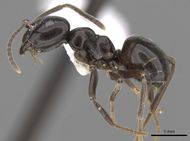Key to Lasius Dendrolasius workers of the East Palaearctic
This worker key is based on: Radchenko, A. 2005. A review of the ants of the genus Lasius Fabricius, 1804, subgenus Dendrolasius Ruzsky, 1912 (Hymenoptera: Formicidae) from East Palearctic. Annales Zoologici. 55(1):83-94.
The ants of the subgenus Dendrolasius are the most peculiar both morphologically and biologically among all Lasius species. These so-called jet black ants have a quite high level of social organisation, form large colonies, usually build big carton nests in living trees, and are characterised by their specific, strong smell. All of them are distinctly bigger than other Lasius species (workers' body size up to 4.5 - 5.5 mm), have shiny black or dark brownish-black body, and a distinctly emarginate occipital margin of the head in most species.
This subgenus includes eight species only (taking into account the present revision), two of which are distributed in the Western Palaearctic (as far east as the Altai Mts.), and six others found in the eastern part of the region, e. g. in the southern part of Russian Far East (as far west as the Amursky Region), north-eastern China, Korean Peninsula, and Japan; one species was also found in Taiwan.
You may also be interested in
1
- Scape strongly dorso-ventrally flattened, ratio of its min/max diameters ~ 0.5 (Figs 32, 33, 41, 42) . . . . . 2
- Scape not dorso-ventrally flattened, elliptical in cross-section, ratio of its min/max diameters > 0.7 (Figs 4, 5, 25, 26, 55, 56, 69, 70) . . . . . 3
2
return to couplet #1
- Petiolar scale (seen in profile) thick, low, not narrowing to the top, with widely rounded dorsal crest, symmetrical; seen in front or from behind, it is the widest at the dorsal crest (Figs 30, 31) . . . . . Lasius orientalis
- Petiolar scale (seen in profile) thin, quite high, asymmetrical, narrowing to the top, with flattened dorsal crest; seen in front or from behind, it is the widest at the level of spiracles, then gradually narrowing to the dorsal crest (Figs 39, 40) . . . . . Lasius spathepus
3
return to couplet #1
- Petiolar scale, seen in front or from behind, distinctly tapering to the top, with very narrowly rounded dorsal crest; seen in profile, it is thin, with flattened dorsal crest (Figs 2, 3). Occipital margin shallowly emarginate (Fig. 1) . . . . . Lasius nipponensis
- Petiolar scale, seen in front or from behind, only slightly narrowing to the top, with widely rounded, straight or slightly emarginate dorsal crest; seen in profile, it is relatively thick, its dorsal crest never flattened (Figs 23, 24, 53, 54, 67, 68). Occipital margin of different shape (Figs 22, 52, 66) . . . . . 4
4
return to couplet #3
- Petiolar scale (seen in profile) thicker, very slightly narrowing to the top, approximately inversely U-shaped (Fig. 53). Occipital margin distinctly emargin;1ted (Fig. 52) . . . . . Lasius fuji
- Petiolar scale (seen in profile) somewhat thinner, distinctly narrowing to the top, approximately inversely V-shaped (Figs 23, 67). Occipital margin of different shape (Figs 22, 66) . . . . . 5
5
return to couplet #4
- Scape with short, but distinct subdecumbent hairs (Figs 25, 26). Occipital margin shallowly emarginate (Fig. 22). Head somewhat longer than broad, at most as long as wide (CI ~ 1.00) . . . . . Lasius capitatus
- Scape with dense decumbent pubescence only (Figs 69, 70). Occipital margin distinctly emarginate (Fig. 66). Head somewhat wider than long (CI 2: 1.04) . . . . . Lasius morisitai











